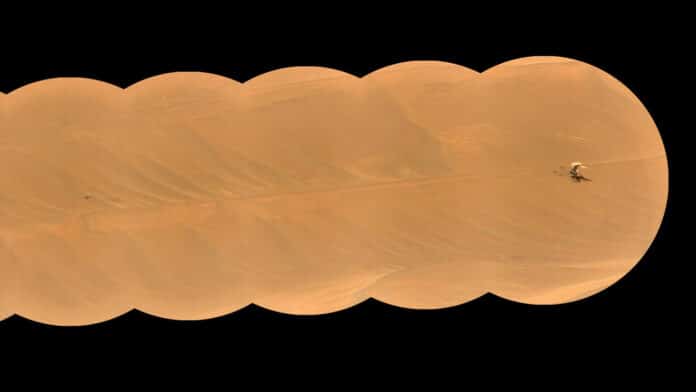The engineers working on NASA’s Ingenuity Mars Helicopter have been closely monitoring the helicopter’s transmission. Recently, engineers gathered one last time in a control room at the Jet Propulsion Laboratory to receive a transmission from the history-making helicopter. Although the mission officially ended in January, Ingenuity has continued to communicate with the Perseverance Mars rover, which serves as a base station for the helicopter.
The latest transmission received through the Deep Space Network marked the last time the mission team would be working together on Ingenuity operations. Ingenuity will now be serving as a stationary testbed, collecting data that could benefit future explorers of Mars.
“With apologies to Dylan Thomas, Ingenuity will not be going gently into that good Martian night,” said Josh Anderson, Ingenuity team lead at JPL. “It is almost unbelievable that after over 1,000 Martian days on the surface, 72 flights, and one rough landing, she still has something to give. And thanks to the dedication of this amazing team, not only did Ingenuity overachieve beyond our wildest dreams, but also it may teach us new lessons in the years to come.”
Originally designed as a short-lived technology demonstration mission that would perform up to five experimental test flights over 30 days, it was the first aircraft on another world to operate from the Martian surface for almost three years. It flew more than 14 times farther than the distance expected and logged more than two hours of total flight time.
Sadly, the mission came to an end as the helicopter experienced a hard landing on its last flight, causing significant damage to its rotor blades. As a result, it won’t be able to fly anymore and will remain at “Valinor Hills” while the Perseverance rover continues its exploration of the western limb of Jezero Crater, which is out of communications range.
The team had a productive and enjoyable time reviewing the latest data from Ingenuity from over 189 million miles (304 million kilometers) away. The telemetry confirmed that a software update previously beamed up to Ingenuity was operating as expected. The new software contains commands that direct the helicopter to continue collecting data well after communications with the rover have ceased.
Ingenuity will now wake up daily, activate its flight computers, and test the performance of its solar panels, batteries, and electronic equipment. Also, the helicopter will take a picture of the surface with its color camera and collect temperature data from sensors placed throughout the rotorcraft.
Ingenuity’s engineers believe such long-term data collection could not only benefit future designers of aircraft and other vehicles for the Red Planet but also provide a long-term perspective on Martian weather patterns and dust movement.
During this final gathering, the team received a farewell message from Ingenuity featuring the names of people who worked on the mission. Mission controllers at JPL sent the message to Perseverance the day before, which was handed off to Ingenuity so that it could transmit the farewell back to Earth.
If something goes wrong with the critical electrical component of Ingenuity in the future, causing data collection to cease, or if the helicopter loses power due to dust accumulation on its solar panel, the data gathered by Ingenuity would remain stored onboard. The team has estimated that Ingenuity’s memory could potentially store up to 20 years’ worth of daily data.
“Whenever humanity revisits Valinor Hills – either with a rover, a new aircraft, or future astronauts – Ingenuity will be waiting with her last gift of data, a final testament to the reason we dare mighty things,” said Ingenuity’s project manager, Teddy Tzanetos of JPL. “Thank you, Ingenuity, for inspiring a small group of people to overcome seemingly insurmountable odds at the frontiers of space.”
